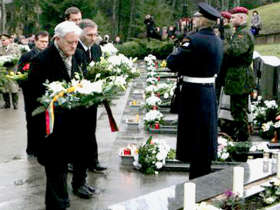VILNIUS’ BLOODY SUNDAY – THEN AND NOW, January 30, 2007

President Valdas Adamkus, Prime Minister Gediminas Kirkilas and Vilnius Mayor Artûras Zuokas laying flowers at the Bloody Sunday memorial on January 13, 2007
Copyright: Dzoja Barysaite
What occurred then shortly after midnight was naked military aggression. Heavily armed Soviet units and tanks were deployed against thousands of unarmed civilians who sought to protect the Vilnius TV tower with their bodies. “When we heard gunfire, my husband and I knew that we had to do something. Together with some friends, we went to the TV tower. And there we sang songs. Suddenly right next to us, several women were thrown to the ground by the shock wave of an artillery blast. And the tanks simply drove right through, over the women’s legs,” recalls Jūratė, a 37-year-old woman today. Two of the women survived; Loreta Asanavičiūtė died a few hours later in the hospital. She was only 23. That night at the TV tower, 13 people—most about age 20—paid the ultimate price in the defense of freedom one year after the Lithuanian Declaration of Independence on March 11, 1990. About a thousand were injured, many severely. Now, crosses arrayed at the foot of the tower (located on what is now known as January 13th Street) as well as numerous other streets in the vicinity renamed to commemorate the individual victims offer testimony to a part of contemporary history that is not even 20 years old. A photo exhibition in the lobby impressively documents the ghastly events of that night. The image of a woman’s bloody legs beneath the treads of a tank were transmitted around the world. Visitors can also view the Soviet plan of attack on the TV tower. After holding it for 222 days, the Red Army finally withdrew on August 22, 1991.
“We had to defend our independence. It was the most natural thing in the world.”
“After all, we were in the right. Why should we run away? It had nothing to do with courage.”
“We fought against communism, not against our Russian brothers.”
The words of Sofija, Vaclovas and Angelė are representative of how most Lithuanians felt.
After Soviet units forcibly occupied the Press Headquarters on January 11, 1991, thousands of unarmed civilians stood guard day and night to protect strategically important buildings. They sang Lithuanian songs and tirelessly chanted “Lietuva” (Lithuania). Even as Russian soldiers were firing over their heads and many people were being wounded by shrapnel, their voices did not fall silent. Others brought tea and food to fortify those who were holding out. Immediately after the bloody clash at the TV tower, two of the leading figures of the Lithuanian struggle for independence—Monsignor Kazimieras Vasiliauskas and Father Robertas Grigas—appeared amidst the crowd assembled in front of parliament. With a plain little table serving as their altar, they celebrated Mass and called upon those in attendance “to also pray for those who are not favorably disposed to our cause.”
Even if financial reparations cannot heal physical and mental wounds, the Seimas, Lithuania’s parliament, nevertheless approved on January 16, 2007 a resolution introduced by Justinas Karosas, chairman of the Foreign Affairs Committee, that calls for initiating negotiations with Russia as successor state of the Soviet Union to enable Lithuania to obtain compensation for damages suffered during the occupation. On the basis of the Compensation Law passed in June 2000, Lithuania already began addressing this issue in 2001 in the context of the Lithuanian-Russian Interstate Commission. Nevertheless, Russia has shown no willingness to negotiate as yet. Demands amount to approximately 80 billion Litas (23 billion euros).
By the way: Vilnius 2009 Director Giedrė Kabašinskienė’s production staff has really begun to take shape since the beginning of the year. The individual team members as well as the brand new concept for “Vilnius – European Capital of Culture 2009” will be presented to the public in February. In early March the presentation of the 57 selected projects will follow.
Translation commissioned by Linz09














